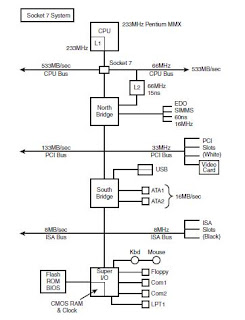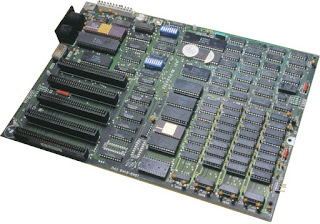Upgrading the BIOS
Upgrading
the BIOS
- The following list shows some of the primary functions of a ROM BIOS upgrade:
- Support for newer and faster processors
- Support for bootable optical drives
- Support for bootable USB drives
- Fast POST for quicker booting
- Support for Serial ATA (SATA) drives
- Plug and Play (PnP) device support and compatibility
- Support for temperature and fan speed monitoring and control
- Support for Wake On Lan (WOL) and network boot
Most BIOS upgrades must be downloaded from the system or motherboard
manufacturer’s website. When seeking a BIOS upgrade for a particular
motherboard, we need to know the following information
§ The make and model of the motherboard
(or system)
§ The version of the existing BIOS
Before
updating a BIOS, save a backup copy of the existing BIOS. That is because some
motherboard manufacturers only offer the latest BIOS for a given motherboard,
and sometimes a newer BIOS may cause problems or have consequences. By having a
backup we will be able to go back to the previous version. To make the backup,
run the BIOS upgrade program for motherboard, and check to see if there is an
option to save the existing BIOS to a file. If that option is not available,
check to see if motherboard manufacturer offers older versions for download. If
there is no option to backup and no older versions can be downloaded, there may
be other ways to make a copy of the BIOS.
Upgrading a
Flash BIOS
Flash ROM
enables to load the upgrade into the flash ROM chip on the motherboard without
removing and replacing the chip. Normally these upgrades are downloaded from
the manufacturer’s website. Depending on the design, some update programs
require that we place the software on a bootable floppy or optical disc, while
others will configure the program to run on the next startup (before Windows
loads), while others will actually run in Windows as a windows application.
Some systems
allow the flash ROM in a system to be locked (write-protected). In that case
you must disable the protection before performing an update-usually by means of
a jumper or switch. Instead of a physical write-protect lock, some flash ROM
BIOS have a security algorithm that prevents unauthorized updates.
Most
downloadable flash ROM upgrades fit into four main types:
- Windows executable upgrades
- Automated images of bootable media
- User-created bootable media
- Emergency recovery media
Windows
executable upgrade
The windows
executable is generally the easiest and most popular method. It might not be
available for older motherboards, but most new boards offer this type of
procedure. Download the executable upgrade program and run it. The program
either runs directly in windows, or it runs an install routine that temporarily
installs the flash upgrade software so it will automatically run on the next
startup and then automatically reboot the system and begin the upgrade. In
either case, once the upgrade is finished, the system reboots again, and the
upgrade is complete. The only drawback to this procedure is that it requires
that Windows 2000 or later be installed on the system.
Automated
bootable media images
This is
ideal for non-Windows systems or new systems where the OS hasn’t yet been
installed. In the case of a floppy, you download the floppy image creation
program from the motherboard manufacturer. When we run it, the program prompts
you to insert a blank floppy disk into the drive, after which it overwrites the
disk with a bootable image containing the bootable OS (most likely DOS or DOS
variant) plus all of the files necessary to perform the upgrade. Then to perform
the upgrade, ensure that floppy drive is set first in the boot sequence and
then restart the system with the upgrade floppy disk in the drive. The system
should then boot from the floppy, and the upgrade procedure should start and
run automatically. Follow any on-screen prompts to complete the upgrade and
then when the upgrade is complete, remove the floppy and reboot the system.
Many
motherboard manufacturers now offer downloadable images of bootable CDs for
BIOS upgrades. These are normally in the form of an *.ISO file, which is a
CD-ROM image file containing a sector by sector copy of a CD. In order to
perform the upgrade, write the ISO bootable image file to a blank CD-R or RW
disc. Then to perform the upgrade, first ensure that the optical drive is set
first in the boot sequence and then restart the system with the upgrade disc in
the drive. The system should boot from the CD and the upgrade procedure should
start automatically. Follow the prompts to complete the upgrade and then, once
the upgrade is complete, remove the CD and reboot the system.
User
created bootable media
Many
motherboard manufacturers also offer BIOS upgrades in the form of a raw
DOS-based flash utility combined with an image file, which can run manually
from any DOS bootable media. Using this technique, the upgrade can be performed
from a bootable floppy, CD, or even a USB flash drive, regardless of whether
the system hard drive is running Windows, Linux or even if it has no OS at all.
The necessary files are normally contained in an archive that can be downloaded
from the motherboard manufacturer. For creating bootable CD some free utilities
like Clean Boot CD package are used. Download the self extracting executable
package into a new folder and run it, which extracts files for your motherboard
into the proper folder. After the files are in place, run the build clean
command which automatically builds and creates an ISO image of a bootable CD,
completes with an OS and files needed. Then use a third party CD/DVD burning
program to copy the ISO image to an actual CD-R or RW disc. After we have
burned the CD, boot from it, navigate to the folder where the flash utility and
image files are located, and enter the appropriate command to execute the
upgrade.
Emergency
Flash BIOS Recovery
Most
motherboards with soldered-in flash ROMs have a special BIOS recovery procedure
that can be performed, which restores the contents of the chip. This hinges on
a special protected part of the flash ROM that is reserved for this purpose,
called the boot block. The boot block holds a recovery routine that can be used
to restore the main BIOS code. Different motherboards and BIOS versions may
have different recovery techniques. Most motherboards that support BIOS recover
incorporate a BIOS configuration jumper, which can set several modes, including
a built in recovery mode.
In addition
to moving the jumper, the recovery requires that either a floppy or optical
drive containing media with the BIOS image file is attached to the system and
properly configured.
To recover
the BIOS using the floppy/optical drive recovery method, perform the following
steps:
- Copy only the proper recovery image file (*.BIO) to a blank formatted floppy disk/CD.
- Place the disk in the primary drive attached to the system to be recovered.
- Power off the system and remove the BIOS configuration jumper to enable BIOS recovery mode.
- Power on the system; the recovery should begin automatically.
- The recovery should complete in 2 to 5 minutes, after which the system will remain running, turn off automatically, or prompt you to turn it off manually.
- With the system powered off, remove the disk and restore the BIOS configuration jumper to enable normal operation.


Comments
Post a Comment